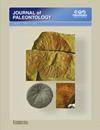Slit-bearing gastropods in the Jane Longstaff Collection at the Natural History Museum, London from the Visean (Carboniferous) of Dalry, Ayrshire, Scotland
IF 1.3
4区 地球科学
Q3 PALEONTOLOGY
引用次数: 0
Abstract
Natural history museums house numerous previously undescribed species and unknown information hidden in their collections. We describe lower Carboniferous slit-bearing gastropods (order Pleurotomariida, subclass Vetigastropoda; and family Goniasmatidae, subclass Caenogastropoda) from previously unreported gastropod collections made by Jane Longstaff (Jane Donald), one of the pioneering paleontologists of Paleozoic gastropods in the late nineteenth and early twentieth centuries. The gastropods were collected from the Lower Limestone Formation (Visean, Brigantian) near Dalry, Ayrshire, Scotland. The collection consists largely of microgastropods, many of which are unusually well-preserved including delicate ornament and protoconchs (larval shells). Three new pleurotomariidan species are described—Biarmeaspira heidelbergerae new species, Neilsonia seussae new species, Tapinotomaria longstaffae new species—in addition to seven species belonging to Borestus Thomas, 1940, Stegocoelia (Stegocoelia) Donald, 1889, Stegocoelia (Hypergonia) Donald, 1892, Donaldospira Batten, 1966, and Platyzona Knight, 1945. The caenogastropod-type protoconch is documented for the first time in Hypergonia, which is therefore placed in Goniasmatidae. The new data confirm that Neilsonia Thomas, 1940 (type genus of Neilsoniinae) belongs to Pleurotomariida and is distinct from the morphologically convergent Peruvispira Chronic, 1949 (Goniasmatidae). The selenizone morphology is identical in Biarmeaspira Mazaev, 2006 and Baylea de Koninck, 1883 during their early ontogeny, and Biarmeaspira develops an angulation on the selenizone (the diagnostic feature) in late ontogeny. This corroborates earlier suggestions that Biarmeaspira evolved from Baylea. Biarmeaspira heidelbergerae n. sp. is the first Carboniferous record of Biarmeaspira, which was previously only known from the Permian. The angulated selenizone evidently evolved several times in Pleurotomariida and the repeated appearance of this character in different groups (e.g., Phymatopleuridae, Eotomariidae, Pleurotomariidae) needs further studies using phylogenetic methods. UUID: http://zoobank.org/92ae9a99-5774-4ee9-bf5d-9a9319494ef6伦敦自然历史博物馆收藏的简-朗斯塔夫(Jane Longstaff)藏品中来自苏格兰艾尔郡达利(Dalry)石炭纪的裂缝腹足类动物
自然历史博物馆收藏了大量以前未曾描述过的物种和未知信息。我们描述了十九世纪末二十世纪初古生代腹足类古生物学家的先驱之一 Jane Longstaff(简-唐纳德)从以前未报道的腹足类收藏中收集到的下石炭统裂缝腹足类(Pleurotomariida 目,Vetigastropoda 亚纲;Goniasmatidae 科,Caenogastropoda 亚纲)。这些腹足类动物采集自苏格兰艾尔郡达利附近的下石灰岩层(维西期、布里干期)。这些藏品主要由微型腹足类组成,其中许多保存异常完好,包括精美的装饰品和原甲壳(幼虫壳)。除了属于 Borestus Thomas(1940 年)、Stegocoelia (Stegocoelia) Donald(1889 年)、Stegocoelia (Hypergonia) Donald(1892 年)、Donaldospira Batten(1966 年)和 Platyzona Knight(1945 年)的 7 个物种外,还描述了 3 个新的胸腹纲物种--Biarmeaspira heidelbergerae 新物种、Neilsonia seussae 新物种和 Tapinotomaria longstaffae 新物种。在 Hypergonia 中首次发现了腹足类原甲壳,因此将其归入 Goniasmatidae。新数据证实,Neilsonia Thomas, 1940(Neilsoniinae 的模式属)属于 Pleurotomariida,与形态上趋同的 Peruvispira Chronic, 1949(Goniasmatidae)不同。Biarmeaspira Mazaev, 2006 和 Baylea de Koninck, 1883 在早期发育阶段的 selenizone 形态是相同的,而 Biarmeaspira 在晚期发育阶段的 selenizone 上出现了一个棱角(诊断特征)。这证实了早先的观点,即 Biarmeaspira 是由 Baylea 演化而来的。Biarmeaspira heidelbergerae n. sp.是Biarmeaspira在石炭纪的首次记录,而此前人们只知道Biarmeaspira来自二叠纪。棱角分明的硒酮显然在 Pleurotomariida 中经历了多次进化,这一特征在不同类群(如 Phymatopleuridae、Eotomariidae、Pleurotomariidae)中的重复出现需要利用系统发生学方法进行进一步研究。UUID: http://zoobank.org/92ae9a99-5774-4ee9-bf5d-9a9319494ef6
本文章由计算机程序翻译,如有差异,请以英文原文为准。
求助全文
约1分钟内获得全文
求助全文
来源期刊

Journal of Paleontology
地学-古生物学
CiteScore
2.80
自引率
7.10%
发文量
94
审稿时长
6-12 weeks
期刊介绍:
The Journal of Paleontology publishes original articles and notes on the systematics, phylogeny, paleoecology, paleogeography, and evolution of fossil organisms. It emphasizes specimen-based research and features high quality illustrations. All taxonomic groups are treated, including invertebrates, microfossils, plants, vertebrates, and ichnofossils.
 求助内容:
求助内容: 应助结果提醒方式:
应助结果提醒方式:


